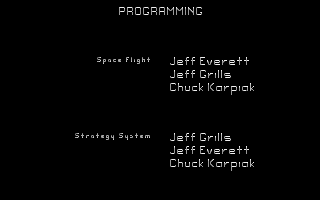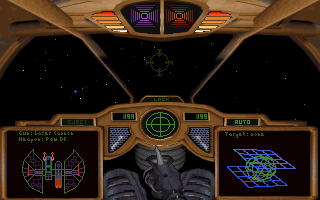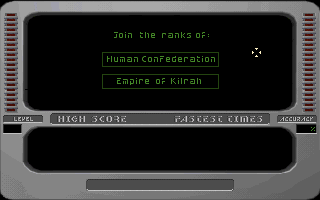Retro Replay Review
Gameplay
Wing Commander: Armada shifts the series from pure flight simulation into the realm of real-time strategy, placing you in command of either the Terran or Kilrathi empire. Instead of piloting a single fighter, you manage entire fleets, allocate resources, and capture star systems on a sector map. Each decision—where to strike, when to reinforce, and what class of ship to build—carries strategic weight, making every campaign feel like a contest of wits as much as firepower.
(HEY YOU!! We hope you enjoy! We try not to run ads. So basically, this is a very expensive hobby running this site. Please consider joining us for updates, forums, and more. Network w/ us to make some cash or friends while retro gaming, and you can win some free retro games for posting. Okay, carry on 👍)
The Armada mode offers a deep tactical layer. You dispatch carriers, battlecruisers, frigates, and fighters across hex-based maps, issuing orders to engage, retreat, or hold formation. You must balance offense and defense, maintain supply lines, and anticipate enemy maneuvers. This complexity rewards thoughtful play: a well-timed flanking attack or surgical strike on an enemy base can turn the tide of a prolonged struggle for dominance.
For those who prefer instant action, the Quick Play mode delivers fast-paced dogfights and fleet engagements reminiscent of Chuck Yeager’s Air Combat’s mission builder. You choose your ships, set simple objectives, and jump straight into battle without the overhead of map-wide strategy. This accessibility makes Armada an attractive pick-up-and-play title when you want space combat without a lengthy setup.
Multiplayer support is a standout feature. Wing Commander: Armada lets you wage war in split-screen, over a local network, via serial cable, or even through a modem dial-up connection. Facing a friend in a head-to-head conquest or coordinating complex maneuvers in cooperative mode adds a whole new dimension to the gameplay. As one of the earliest multiplayer 3D space sim-strategy hybrids, it remains a milestone in bridging the gap between dogfighting and grand strategy.
Graphics
Visually, Armada was cutting-edge for its time, showcasing fully rendered 3D ship models against richly star-studded backgrounds. While polygon counts are modest by today’s standards, the designers used texture shading and glow effects to give fighters and capital ships a distinctive silhouette. Explosions, energy beams, and engine thrusts light up the dark void of space with satisfying flair.
The tactical map interface is clean and functional. Hex tiles clearly delineate movement ranges, and unit icons are color-coded by faction and ship class. Pop-up windows display hull strength, shield levels, and weapon ranges, letting you assess the state of play at a glance. This blend of 2D UI elements and 3D visuals strikes a solid balance between clarity and atmosphere.
During battles, camera controls allow you to zoom in for a close-up of capital ship broadsides or pull back for a grand overview of fleet formations. Animations for launches, warp jumps, and destroyer barrages are gratifying—though brief loading pauses between mission stages can interrupt the flow if you’re moving large fleets.
Despite its age, Armada’s art direction still conveys the epic scale of interstellar warfare. The Kilrathi dreadnoughts, with their feline motifs, stand in stark contrast to the sleek, modular Terran vessels. Those emblematic designs, paired with atmospheric starfields and dynamic lighting, keep the experience visually engaging even decades after release.
Story
Set in the beloved Wing Commander universe, Armada casts you at the head of the long-running conflict between humanity’s Terran Confederation and the territorial Kilrathi Empire. The narrative framework is straightforward: conquer the sector, crush your enemy, and claim strategic starbases to expand your reach. While there are no fully animated cutscenes, brief text interludes and mission briefings provide context for each engagement.
The branching nature of the campaign map lets the story evolve based on your successes or failures. Conquer a key junction world, and you open new attack vectors; lose too many ships, and you risk strategic collapse. This emergent narrative—crafted by your own decisions—can feel more compelling than a strictly scripted storyline, because every commander’s war plays out differently.
Character development is minimal compared to other Wing Commander titles: there are no named heroes or deep personal subplots. Instead, the focus is on the broader conflict and the ebb and flow of territorial gains. For players seeking dramatic cutscenes or voice-acted dialogue, Armada’s story may seem sparse. But for strategy enthusiasts, the high stakes of each campaign map often provide enough drama to keep you invested.
Links to the larger Wing Commander saga come through familiar ship designs, faction emblems, and references to past battles. If you’ve flown with Blair or sparred with Maniac in previous titles, you’ll appreciate the nods to series lore. These touches create a sense of continuity, reminding you that your strategic gambits fit into a decades-long galactic war.
Overall Experience
Wing Commander: Armada sits at a fascinating crossroads between simulation and strategy. It retains the franchise’s signature space combat thrills while inviting you to think several steps ahead on a sector map. The dual-mode structure—Armada for deep tactics, Quick Play for rapid engagements—ensures there’s something here for both hardcore strategists and fans of aerial dogfights.
Multiplayer remains a highlight. Whether duking it out in split-screen on a single machine or coordinating complex fleet operations over a network, few early 3D space sims offered such flexibility. Today, vintage-gaming enthusiasts still convene over serial emulators, marveling at how pioneering this title was for its multiplayer ambitions.
Certain elements show their age: the user interface can feel cumbersome when managing dozens of ships, and the graphics, though ambitious, lack the polish and detail of modern engines. Occasional slowdowns on larger battles remind you that you’re working within mid-90s hardware constraints. Yet these quibbles are outweighed by the depth and replay value Armada delivers.
For potential buyers, Wing Commander: Armada is best suited to those who love strategic planning and space combat equally. If you’ve ever dreamed of commanding a fleet of carriers and dreadnoughts, or if you simply crave a fresh twist on the Wing Commander brand, Armada delivers an engaging, technically pioneering experience that still stands up as a landmark in space-strategy gaming.
 Retro Replay Retro Replay gaming reviews, news, emulation, geek stuff and more!
Retro Replay Retro Replay gaming reviews, news, emulation, geek stuff and more!









Reviews
There are no reviews yet.